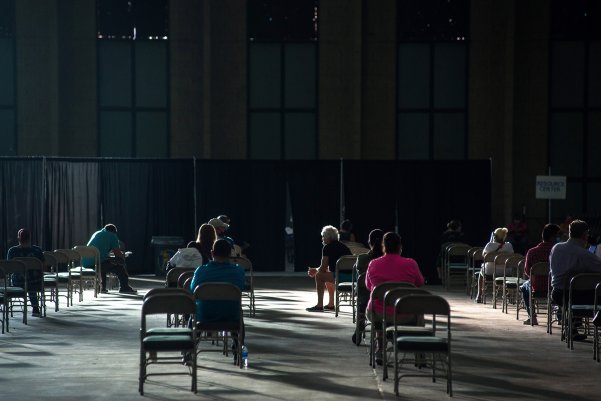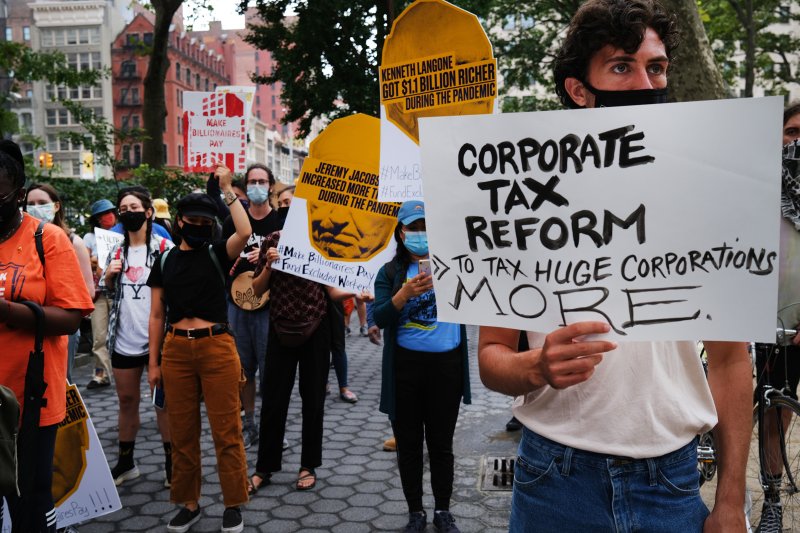The Top 1% of Americans Have Taken $50 Trillion From the Bottom 90%—And That's Made the U.S. Less Secure

Like many of the virus’s hardest hit victims, the United States went into the COVID-19 pandemic wracked by preexisting conditions. A fraying public health infrastructure, inadequate medical supplies, an employer-based health insurance system perversely unsuited to the moment—these and other afflictions are surely contributing to the death toll. But in addressing the causes and consequences of this pandemic—and its cruelly uneven impact—the elephant in the room is extreme income inequality.
How big is this elephant? A staggering $50 trillion. That is how much the upward redistribution of income has cost American workers over the past several decades.
This is not some back-of-the-napkin approximation. According to a groundbreaking new working paper by Carter C. Price and Kathryn Edwards of the RAND Corporation, had the more equitable income distributions of the three decades following World War II (1945 through 1974) merely held steady, the aggregate annual income of Americans earning below the 90th percentile would have been $2.5 trillion higher in the year 2018 alone. That is an amount equal to nearly 12 percent of GDP—enough to more than double median income—enough to pay every single working American in the bottom nine deciles an additional $1,144 a month. Every month. Every single year.
Price and Edwards calculate that the cumulative tab for our four-decade-long experiment in radical inequality had grown to over $47 trillion from 1975 through 2018. At a recent pace of about $2.5 trillion a year, that number we estimate crossed the $50 trillion mark by early 2020. That’s $50 trillion that would have gone into the paychecks of working Americans had inequality held constant—$50 trillion that would have built a far larger and more prosperous economy—$50 trillion that would have enabled the vast majority of Americans to enter this pandemic far more healthy, resilient, and financially secure.
As the RAND report [whose research was funded by the Fair Work Center which co-author David Rolf is a board member of] demonstrates, a rising tide most definitely did not lift all boats. It didn’t even lift most of them, as nearly all of the benefits of growth these past 45 years were captured by those at the very top. And as the American economy grows radically unequal it is holding back economic growth itself.

Even inequality is meted out unequally. Low-wage workers and their families, disproportionately people of color, suffer from far higher rates of asthma, hypertension, diabetes, and other COVID-19 comorbidities; yet they are also far less likely to have health insurance, and far more likely to work in “essential” industries with the highest rates of coronavirus exposure and transmission. It is no surprise then, according to the CDC, that COVID-19 inflicts “a disproportionate burden of illness and death among racial and ethnic minority groups.” But imagine how much safer, healthier, and empowered all American workers might be if that $50 trillion had been paid out in wages instead of being funneled into corporate profits and the offshore accounts of the super-rich. Imagine how much richer and more resilient the American people would be. Imagine how many more lives would have been saved had our people been more resilient.
It is easy to see how such a deadly virus, and the draconian measures required to contain it, might spark an economic depression. But look straight into the eyes of the elephant in the room, and it is impossible to deny the many ways in which our extreme inequality—an exceptionally American affliction—has made the virus more deadly and its economic consequences more dire than in any other advanced nation. Why is our death toll so high and our unemployment rate so staggeringly off the charts? Why was our nation so unprepared, and our economy so fragile? Why have we lacked the stamina and the will to contain the virus like most other advanced nations? The reason is staring us in the face: a stampede of rising inequality that has been trampling the lives and livelihoods of the vast majority of Americans, year after year after year.
Of course, America’s chronic case of extreme inequality is old news. Many other studies have documented this trend, chronicled its impact, and analyzed its causes. But where others have painted the picture in terms of aggregate shares of GDP, productivity growth, or other cold, hard statistics, the RAND report brings the inequality price tag directly home by denominating it in dollars—not just the aggregate $50 trillion figure, but in granular demographic detail. For example, are you a typical Black man earning $35,000 a year? You are being paid at least $26,000 a year less than you would have had income distributions held constant. Are you a college-educated, prime-aged, full-time worker earning $72,000? Depending on the inflation index used (PCE or CPI, respectively), rising inequality is costing you between $48,000 and $63,000 a year. But whatever your race, gender, educational attainment, urbanicity, or income, the data show, if you earn below the 90th percentile, the relentlessly upward redistribution of income since 1975 is coming out of your pocket.

No comments:
Post a Comment
Note: Only a member of this blog may post a comment.